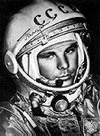Spaceflight and Spacecraft Beginnings
by Jeanette Cain
More articles in SatellitesThe Soviet Union was the first nation to ever launch an artificial satellite into the realm of space. Sputnik was the invention of Sergei Korolev, who was an architect in the space program of the Soviet Union. Sputnik caused excitement and fear as it transmitted a tracking signal for twenty-one days. The date: October 4, 1957.
On November 3, 1957, Sputnik 2 was launched carrying a passenger. Laika, a dog, had the eyes of the world on her space flight. Laika was the first ever living creature from Earth to travel in space. Unfortunately, Laika died when the oxygen in Sputnik 2 ran out in orbit.
The next dogs to enter space were Belka and Strelka. They were the occupants on Sputnik 5 when it was launched into space on August 4, 1960. The satellite was signaled back to Earth after one day in orbit. Belka and Strelka were the first survivors of space weightlessness and satellite re-entry.
On April 12, 1961, the first person to travel in space was the Soviet Union's Yuri Gagarin. The trip was in the Vostok spaceship, which had an ejector seat on rails.
Yuri Gagarin was a great success for the Soviet space program, since it was recovering from two disasters that had killed many people. The disaster gave scientists the knowledge to construct and build launching centers that were in remote, out-of-the-way places, where humans would not be harmed.

On May 5, 1961, the United States space program launched Alan Shepard into space. Shepard returned to Earth after reaching an altitude of 180 km. This was part of the Mercury astronaut program from 1958 through 1963. The Mercury program's aim was to launch an astronaut into space and to make observations of his reactions before returning him safely to Earth's surface.
The Apollo program was launched on May 25, 1961 by then President John F. Kennedy. Kennedy told the Americans and the world that the Apollo lunar exploration program was underway. Kennedy rallied the American people behind him by saying that getting to the Moon would be difficult, not easy, which was the reason for this undertaking.
On March 18, 1965, Alexei Leonov, a Soviet cosmonaut, made the first space walk from the Voskhod 2. Leonov spent more time walking in space than planned. As he began his spacewalk, the spacesuit expanded making it difficult to re-enter the airlock. After 20 minutes in space Leonov finally close the outer hatch.
The United States Gemini program became the stepping stone from Mercury to Apollo. The Gemini 7 lasted 14 days in space. It had a cockpit to hold two astronauts and a module that contained fuel, oxygen, and food. The Gemini program paved the wave for lunar exploration. Gemini 6 and 7 were the first spacecraft to make a rendezvous at 260 km altitude and about 30,000 km per hour.
The first person to die in space was the Soviet cosmonaut, Vladimir Komarov. His spacecraft was the Soyuz 1. Three American astronauts had died four months earlier when a fire rushed through the Apollo 1 spacecraft they were testing.
On July 20, 1969, Neil Armstrong, commander of the US Apollo 11, arrived with his crew on the first ever Moon landing. The lunar module, Eagle, was guided by Armstrong and Buzz Aldrin to the Moon's surface, but Michael Collins stayed in control of the command module. Armstrong and Aldrin spent 2 and a half hours outside the Eagle, and collected rock and dust samples weighing 22 kg. Total time spent on the surface of the Moon was 22 hours.
The Soviet Union was the first nation to provide a space laboratory for the purpose of research and experimentation. Salyut 1 was the first and equipped with an engine for changing orbit, plus a docking station. Soyuz 10 and 11 visited Salyut, but the crew of Soyuz 11 were killed when a seal on the descent module failed to act during the return to Earth.
From July 15th through the 24th of 1975, the Soviet Union and the United States worked together on a space mission. The Apollo-Soyuz rendezvous spaceships and crew came together and docked. They carried on science experiments together for several days, but completely their mission independent of the other.
Sources:
1. Couper, Heather and Nigel Henbest. Space Encyclopedia DK Publishing, Inc.: NY 1999
2. Editors. Secrets of the Universe. International Master Publishing: US. 1999